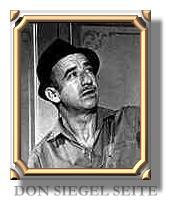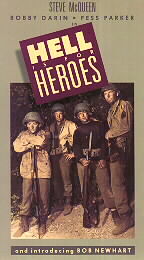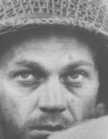 |
Paramount - 89 m - USA 1961 |

ANALYSE
INFOS
 |
Paramount - 89 m - USA 1961 |

ANALYSE
INFOS
| Noch einmal eine Kampfepisode aus dem Zweiten Weltkrieg zu Ehren amerikanischen Soldatentums. 1944 in Frankreich, Nähe Montigny, in einer bisher ruhigen Stellung am Westwall: Eine Urlaub erwartende Gruppe kommt zum Fronteinsatz. Sie täusch erfindungsreich eine starke Besetzung vor; dazu gehört unter anderem ein wahnwitziger Angriff auf ein beherrschendes deutsches MG-Nest in einem Bunker. Diesen Angriff unternimmt während kurzer Abwesenheit des Gruppenführers ein ebenso draufgängerischer wie unansprechbarer Mann, der als Offiziersanwärter wegen Totschlags in Trunkenheit degradiert wurde, dem Typus nach eine Mördernatur. (Lex. des Int. Films) |
| Steve McQueen
(Foto)
Bobby Darin Nick Adams Fess Parker Harry Guardino James Coburn L.Q. Jones Mike Kellin Joseph Hoover Michele Montau Bill Mullikin Bob Newhart Don Haggerty
|
- Reese
- Pvt. Corby - Homer - Sgt. Pike - Sgt. Larkin - Cpl. Henshaw - Sgt. Frazer - Pvt. Kolinsky - Capt. Loomis - Monique - Pvt. Comberly - Pvt. Driscoll - Capt. Mace |
Don Siegel
Henry Blanke Richard Carr Robert Pirosh Harold Lipstein Howard A. Smith Hal Pereira Howard Richmond Robert R. Benton Sam V. Comer Wally Harton Bob Hickman William Morley Wally Westmore Dick Webb William McGarry Philip Mitchell John Wilkinson
|
- Regie
- Produzent - Drehbuch - Drehbuch - Kamera - Musik/Komponist - Schnitt - Art Director - Art Director - Set Decoration/Design - Set Decoration/Design - Kostüme - Makeup - Makeup - Makeup - Special Effects - Asst. Director - Sound/Sound Designer - Sound/Sound Designer |
 "Hell is for Heroes is a film I inherited
and which I didn't begin. It's an honest film which has something to say.
At the beginning I refused to shoot certain scenes which seemed to me too
anodyne, too delicate for a war film. It would have turned out more like
a brass band regiment. But I do think war's a sordid thing. I tried to get
to the heart of it and my film is, I think, extremely realistic. I really
felt the picture began when we got up on the ridge. I thought that the stuff
in the studio was pretty obviously studio
stuff, which was unfortunate. I think we'd have been much better and much
less Hollywood if I'd just started the picture on the ridge, really right
within it. But I wasn't equal to it, and there was great pressure of time
and quite a rewrite. I'm particularly pleased with the last shot and, in
fact, with the entire ending in which Steve McQueen is killed and the battle
goes on as the picture ends. That wasn't the end of the picture as we had
written it. The end was more affirmative and we had shot it taht way but
when I was editing the picture I realised "Hell is for Heroes is a film I inherited
and which I didn't begin. It's an honest film which has something to say.
At the beginning I refused to shoot certain scenes which seemed to me too
anodyne, too delicate for a war film. It would have turned out more like
a brass band regiment. But I do think war's a sordid thing. I tried to get
to the heart of it and my film is, I think, extremely realistic. I really
felt the picture began when we got up on the ridge. I thought that the stuff
in the studio was pretty obviously studio
stuff, which was unfortunate. I think we'd have been much better and much
less Hollywood if I'd just started the picture on the ridge, really right
within it. But I wasn't equal to it, and there was great pressure of time
and quite a rewrite. I'm particularly pleased with the last shot and, in
fact, with the entire ending in which Steve McQueen is killed and the battle
goes on as the picture ends. That wasn't the end of the picture as we had
written it. The end was more affirmative and we had shot it taht way but
when I was editing the picture I realised
 that at
the peak of the battle I had nothing else I wanted to say, no feeling of
possible affirmation. I wanted to show that my hero was blown up, which was
horrifying, and that the rest were still going forward, that he would be
forgotten, that the action of the war is futile. i hadn't designed anything
for an ending like that, so I optically zoomed in on the pill box. It didn't
bother me a bit that it was grainy. it had an authentic quality and it made
me feel right about the picture." that at
the peak of the battle I had nothing else I wanted to say, no feeling of
possible affirmation. I wanted to show that my hero was blown up, which was
horrifying, and that the rest were still going forward, that he would be
forgotten, that the action of the war is futile. i hadn't designed anything
for an ending like that, so I optically zoomed in on the pill box. It didn't
bother me a bit that it was grainy. it had an authentic quality and it made
me feel right about the picture."
(Lovell Interviews, S. 56) ----------------------------------------------------------------------------------------------------- Die ins Gras beißen ist ein Film, den ich übernommen habe, den ich nicht selber angefangen habe. Es ist ein ehrlicher Film mit einer Botschaft. |
| Frage: Wie ist es möglich, daß Don Siegel einen so
heroischen Film wie HELL IS FOR HEROES (...) gedreht hat? Siegel: Diese Frage erstaunt mich, weil ich an HELL IS FOR HEROES nichts Heroisches finde und ihn auch nicht heroisch gedacht habe. Das ist eine ganz unerbittliche Kriegsgeschichte, die nichts anderes sagen will als das: es ist ganz gleich, ob du stark oder schwach, ein Feigling oder ein Held bist, ein guter oder eins chlechter Krieger: die Chance zu sterben ist die gleiche und der Tod ist so und so sinnlos. Heiko R. Blum: Gespräch mit Don Siegel. epd Film 6/1991 |
| ---allmovie---imdb---lexikon des internationalen films--- |